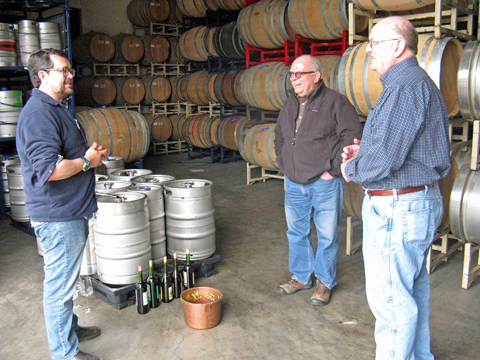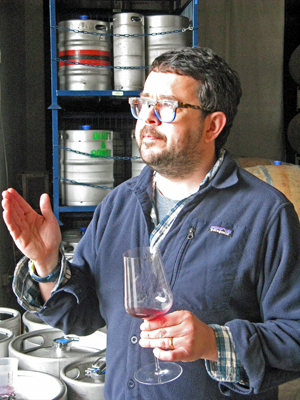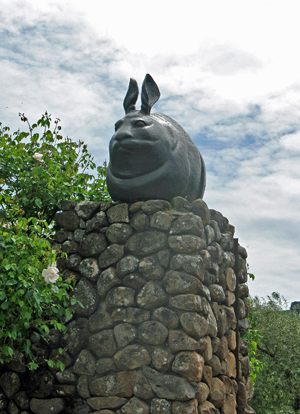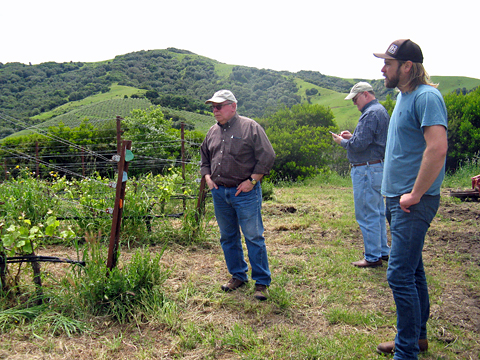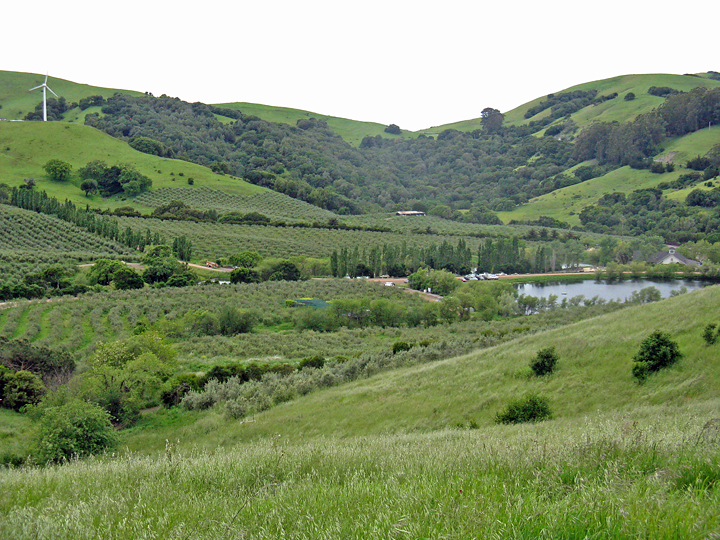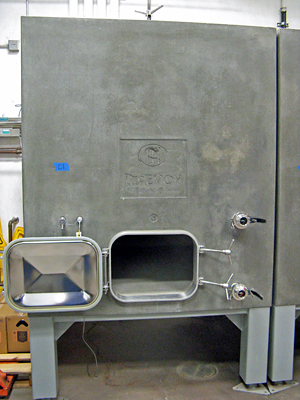Sonoma County Tour - April 2017 - Part 1
Prologue
Around the beginning of the year, I mentioned to Eric Anderson that I thought the time was right for us to do another wine tour of Sonoma County. I’d been keeping a list of producers in that area that I wanted to visit and it was starting to overflow. So we looked at potential dates when we could make it and settled on three days in late April. Eric’s friend Michael Poston, who’s joined us on a few previous Grape-Nutz wine tours, was able to come along as well.
As I began to contact vintners to arrange appointments for our visits, I found I was focusing mostly on producers that were fairly new – labels that had been around for 10 years or less. As it turned out, eight of the nine producers we visited on this trip fell into that category, along with one that dates back for 50 years and is one of the area’s best-known. And with one exception, none of us had ever made in-depth visits to any of the vintners we would be seeing during our three-day tour – there would be lots of first-time winery stops.
We planned a mid-week wine tour, and Eric and Michael drove up from Southern California on a Monday. The first day of winery visits was the following day, which was overcast with unsettled weather, looking like we might be in for a little rain. I drove from Oakland that morning, and we met up in the parking lot outside our first winery destination of the day.
Dirty and Rowdy Family Wines
Tasting Notes: Current Releases & Barrel Samples |
Dirty and Rowdy 2016 Mourvèdre, “Especial,” Alder Springs Vineyard Mendocino. Light color, almost rosé-like, this had bright and savory aromas – black cherry, fresh herbs, earth, and touches of stone fruit and stony minerals. Light and fresh mouthfeel with light tannins and a clean finish – very nice rendition of a lighter Mourvèdre.
Dirty and Rowdy 2016 Mourvèdre, “Familiar,” California. 85% Mourvèdre plus 5% each Petite Sirah, Carignane, and Zinfandel. Beautiful floral aromas along with earth, fresh plums, and wet stones. Nice texture with moderately chalky tannins – another nice light Mourvèdre with a bit more structure than the “Especial” bottling.
Dirty and Rowdy 2015 Mourvèdre, Skinner Stoney Creek Vineyard, El Dorado. Upfront floral aromatics with a riper black cherry fruit component, spice, and herbal undertones. Medium weight with a richer mouthfeel than the first two wines, finishing with chalky tannins – quite pleasant now but should be good for medium-term cellaring too.
Dirty and Rowdy 2014 Mourvèdre, Antle Vineyard, Chalone. A bit darker in color, this showed more of the slightly stemmy whole-cluster character on the nose than the earlier wines, along with raspberry fruit, and notable earth, spice, and savory elements. Bigger structure with a firm tannic grip, this will need more time to show its best.
Dirty and Rowdy 2016 Viognier, Alder Springs Vineyard, Mendocino. Stone fruit and citrus aromas with slightly floral undertones. Zippy acidity with a stony mineral quality on the finish, a refreshing rendition of Viognier.
Dirty and Rowdy 2016 Mourvèdre, Shake Ridge Ranch, Amador (barrel sample). This showed ripe, upfront red fruit, with savory herbal notes in support. Nice texture with moderate tannins.
Dirty and Rowdy 2016 Mourvèdre, Antle Vineyard, Chalone (barrel sample). Plenty of spice aromas on this wine, along with savory notes and a darker fruit character than the Shake Ridge. Bigger and more structured, but the tannins were not aggressive.
Dirty and Rowdy 2016 Mourvèdre, Enz Vineyard, Lime Kiln (barrel sample). A bit darker color, with aromas of blackberry and earth, plus a meaty quality. This had plenty of structure and a fairly grippy tannic finish – good potential.
Dirty and Rowdy 2016 Petite Sirah, “Spring Street Vineyard,” Napa Valley (barrel sample). Very dark color, with mocha, blackberry, earth, and lots of black pepper on the nose – quite Syrah-like in character. Bright and lively on the palate, with big but not aggressive tannins on the finish – very promising young Petite.
|
|
Our first visit on Tuesday was with Hardy Wallace of Dirty and Rowdy Family Wines. The winery is located at the Cruse Wine Co. facility in Petaluma, where they are a custom crush client (Enfield Wine also does a small amount of their production there). Eric, Michael, and I were still outside in the parking area catching up on things when Hardy came out to greet us. I’d first run across the Dirty and Rowdy wines in spring 2013 at the Seven % Solution wine tasting in Healdsburg, and they intrigued me right away. I’d tried to arrange a visit with Hardy a couple of times over the past few years but we had not been able to coordinate a time until this visit.
Hardy was first introduced to fine wine when he was working in technology sales in Atlanta. With the company he worked for footing the bill, he was able to order highly-regarded wines at sales dinners. When the economic downturn hit in 2008, he found his wine budget cut back but he took that as an opportunity to learn more about interesting but less pricey wines than the Bordeaux and Napa Cab he’d impressed clients with before. Ultimately, Hardy was laid off from his job, and with increasing interest in wine, he thought about making a change to work in the wine industry. The timing turned out to be perfect, as Murphy-Goode Winery in Healdsburg was promoting a contest to become the winery's "lifestyle correspondent" – they called it "A Really Goode Job." Hardy entered the contest with a video made by his friend Matt Richardson, and he won the job over 2,000 other applicants.
After his successful gig with Murphy-Goode was completed, Hardy decided he wanted to stay in Northern California wine country. He worked for a time with Kevin Kelley at Salinia Wine Company, then spent a summer working in the vineyard with noted grower Ann Kraemer at Shake Ridge Ranch in Amador County. He went on to work with Ehren Jordan of Failla Winery during crush in 2011 and then for about 1½ years with Cathy Corison of Corison Winery. By this time, Hardy had already established Dirty and Rowdy Family Wines, along with Matt Richardson and their wives Kate and Amy, and Hardy has made the winery his full-time job since 2013. Matt and Amy still live in Atlanta, though the long-term goal is for them to move to California to become a more hands-on part of the business. It’s sometimes asked “who’s Dirty and who’s Rowdy?” The names come from blogs that Hardy and Matt had each started in Atlanta – Hardy’s was Dirty South Wine, and Matt’s was Rowdy Food. During our visit with Hardy, he often referred to Matt as “Rowdy.” Wonder if Matt calls Hardy “Dirty” – that’s a question for another time!
Dirty and Rowdy has become known for Mourvèdre, one of the very few California wineries to focus on this variety. But that’s not at all what Hardy and Matt had originally envisioned. The plan was to make some wine in 2010 (while Hardy was working for Kevin Kelley), but they’d hoped to make a skin-fermented dry Muscat. An unusually cool summer that year led to many growers doing aggressive leaf-pulling in their vineyards, then a couple of late summer heat spikes resulted in a lot of that exposed fruit getting burned by the hot sun, including the Muscat. The same fate befell the fruit for Hardy’s second choice, a dry white Zinfandel. A third option – Petite Sirah – rotted on the vine due to harvest season rains before the fruit was ripe. With harvest season starting to wind down and options for fruit dwindling, Hardy heard about a small amount of Mourvèdre available from Santa Barbara Highlands Vineyard, a high-elevation site in eastern Santa Barbara County. He and Matt decided to take a shot with this, and since Hardy was a fan of Cru Beaujolais and Loire Valley reds, he thought he’d try to make the wine in a similar, lighter style. The two barrels of this initial Mourvèdre created an immediate buzz, and ever since, demand has exceeded supply for Dirty and Rowdy.
The winery has grown from that initial one-ton lot of Mourvèdre in 2010 to the equivalent of around 3,700 cases in barrel for the 2016 vintage. In 2011, Hardy connected with Ann Kraemer at Shake Ridge for Mourvèdre fruit from her vineyard, and he’s added more vineyards for Mourvèdre since then – now up to nine of them. Hardy told us that he would like to grow the label to about 5,000 cases per year in the short term, mainly by increasing the production of the white and red “Familiar” blends that use fruit from multiple vineyard sources. The longer-term goal is to reach the 10,000-case level so Matt and Amy can move to California to become more involved in the project. Hardy used to make his wines at Punchdown Cellars in Santa Rosa (the old Copain Custom Crush) but moved his production of white wines to the Cruse facility in 2013 and moved all his production there in 2016.
Hardy led Eric, Michael, and me back through part of the winery, showing us some features along the way. There are a few concrete fermenters along with a number of stainless steel tanks. Hardy told us that he likes concrete for the cooler and consistent fermentation temperatures it provides. He uses concrete to ferment most reds, but other than a few wines that are aged in smaller concrete eggs, everything is aged in stainless steel tanks or neutral barrels. Hardy is known for minimal intervention in his winemaking, but he said that he’s not dogmatic about his methods. He uses whole-cluster and whole-berry fermentation for the reds, and often a portion of the white grapes undergo skin-contact fermentation. Fermentations are not inoculated, and Hardy stays away from additions of water, acid, nutrients, etc. in the wines. Reds are generally pressed right away when they go dry, and the barrels for aging (almost all are barriques) range from 4 to 12 years old. Single-vineyard Mourvèdres spend about 10-12 months in barrel, with some spending more time in bottle prior to release than others. Typically anywhere from 25-60% of the barrels for each Mourvèdre go into the vineyard-designated bottlings, while the rest go into the larger “Familiar” blend.
Hardy aims for a consistent winemaking style – nearly all the Mourvèdres are made in a very similar way – so that the vineyard distinctions of each wine show through clearly. His goal is to source from interesting and distinctive sites, so the wines are easily distinguished from one another – after tasting a number of the single-vineyard Mourvèdre bottlings, that’s something he’s done very well. Hardy feels that Mourvèdre is capable of showing more terroir than most people give it credit for, and it can be made in all sorts of styles from rosé to lighter reds to bigger but still-balanced reds. While there is a range from lighter to bolder in the Dirty and Rowdy wines, they maintain remarkably modest alcohol, mostly in the 12-13% range.
Besides Mourvèdre, Dirty and Rowdy has been known for its Sémillon, which has been partly fermented on the skins. They haven’t made any since 2014 (they lost access to the vineyard) but they should have a new source starting in 2018. The other wine they’re known for is Petite Sirah – they make three different bottlings from this variety, from Mendocino County plus a new one from Napa Valley. In addition to their “Familiar” Mourvèdre bottling, Dirty and Rowdy also makes a “Familiar Blanc” – a blend that has included Chenin Blanc, Pinot Blanc, Chardonnay, Melon de Bourgogne, Roussanne, and Viognier, some of which is skin-fermented. They also make smaller amounts of Viognier, Chardonnay, Cabernet Sauvignon, and a sparkling Pinot Blanc. In addition, Dirty and Rowdy teams up with Cruse Wine Co. on a Furmint from Alder Springs Vineyard. The two “Familiar” bottlings are the largest-production wines, and they have wider distribution than the others, which are generally only available through the winery’s mailing list and website.
Hardy started us off on tasting some of his current bottlings, beginning with the 2016 “Especial” Mourvèdre, made for early release and early drinking. It was fermented with whole clusters – and mostly whole-berry – in an open-top concrete fermenter, then pressed early to finish in concrete eggs, with no sulfur added until just before bottling. The vineyard composition of the “Especial” varies from year to year, and it was 100% Alder Springs fruit in 2016. This site, in far north Mendocino County, has numerous vineyard blocks, with this one being on a south-facing slope at 2,400-foot elevation with sandstone soil. An unusual but very pleasant lighter take on Mourvèdre – Eric described it as “Gamay-like.”
The 2016 “Familiar” Mourvèdre bottling is just being released. Made more for freshness and drinkability when young than the single-vineyard bottlings, the 2016 vintage was sourced from about 50% Antle Vineyard in the Chalone appellation, plus some from Shake Ridge and a little from the old vines of Evangelho Vineyard in Contra Costa County. It’s an early-drinking rendition of Mourvèdre with more heft than the “Especial.” We continued with two single-vineyard Mourvèdre bottlings, a 2015 from Skinner Stoney Creek Vineyard and 2014 from Antle Vineyard. Located in El Dorado’s Fair Play region, the Stoney Creek site has granitic soil. Hardy also makes a Mourvèdre from Skinner White Oak Flats, farther north and at a lower elevation. I thought the Stoney Creek bottling was almost Pinot-like in its floral aromatics and seamless texture. Antle Vineyard was planted by longtime Chalone vintner Dick Graff in the limestone and granite soil that the Chalone region is noted for. This bottling spends more time in bottle before release due to its more tannic structure – something that most red wines from the region are noted for.
The final bottled wine that Hardy poured for us was the winery’s first Viognier. He told us that Viognier has generally not been a favorite of his as a varietal, but he found that this wine was something different. He’s used some Viognier from Alder Springs in the “Familiar Blanc” blend, typically making an earlier and later pick there. In 2016, Hardy liked the first pick well enough to release on its own. It was fermented in older oak and then transferred to a concrete egg. Unlike too many soft and over-ripe California Viogniers, this one has great energy to it.
I should note the distinctive and humorous labels of the Dirty and Rowdy wine – instantly recognizable and featuring light-hearted caricatures of Hardy and Matt in different situations. We noticed the closures used for the wines – Nomacorc closures with material derived from sugar cane, they have controlled oxygen transfer, plus they’re recyclable and have a low carbon footprint. A few bottlings that are meant for longer-term aging will still get high-quality natural cork closures, including a special 2016 Petite Sirah we had a chance to sample.
Discussing recent vintages with Hardy, he feels that the 2014 and 2015 wines will have long aging potential. He also told us that he’s “almost afraid” of how well the 2016 wines are coming along and how good that vintage will turn out.
Since we all had a little extra time, Hardy pulled a few 2016 barrel samples for us, starting with Mourvèdre from Shake Ridge Ranch. The site is on volcanic soil at about 2,000-foot elevation – like many Amador vineyards, it’s fairly warm there though this particular site gets quite cool at night. Hardy noted that this wine is being aged partly in 600-liter demi-muid barrels as he feels they may work well with the Shake Ridge wine. Next up was a sample of Mourvèdre from Antle Vineyard, and we then tasted one more Mourvèdre, from Enz Vineyard in the Lime Kiln AVA of San Benito County. The vines there are nearly 100 years old, dry-farmed and own-rooted in mostly decomposed granite soil. Unlike most of the Dirty and Rowdy Mourvèdres, this one had an extended maceration of about 1½ -2 weeks before pressing. Hardy noted that the thick skins of the berries at Enz contribute to the tannic finish.
We finished up our tasting with a 2016 Petite Sirah barrel sample. This is from a new vineyard for the winery – a site next to Spottswoode near St. Helena with vines that are about 45 years old. Hardy said that the vineyard currently has no official name, and they’re calling it “Spring Street” for now but it may well be called something else by the time the wine is released. This is a special wine for Hardy, as he intends it to be a birth-year wine for his daughter, born in 2016. He feels that it will have a longer aging potential than most of his wines so it should be a good choice for Hardy and Kate’s daughter to have when she’s old enough. The wine – though still very young – showed great potential, and Hardy feels it may be the best he’s made yet. Eric called it “the best Petite I’ve ever had.” Certainly a fine way to conclude our tasting!
This was a terrific start to our brief wine tour and it turned out to be one of the most memorable stops of the three days. I really enjoyed all of the current Dirty and Rowdy releases that Hardy poured for us, the four Mourvèdre bottlings in particular. It’s hard to choose a favorite among them – they’re all highly distinctive and each one fills a singular slot in the Dirty and Rowdy wine line-up, from light to bigger and from “drink now” to “put this in the cellar for awhile.” I suppose if I had to choose, the 2016 “Familiar” bottling offers a great combination of drinkability and complexity. Among the 2016 barrel samples, I thought the Enz Vineyard Mourvèdre and Spring Street Vineyard Petite Sirah were standouts. I found a minerally quality to many of the wines that was quite intriguing and appealing.
I saw a different side of Hardy on this occasion. His public persona can be super-animated and sometimes a little bit crazy, but during our visit he showed his serious side. As with all good vintners, he’s passionate and knowledgeable about what he’s doing, and he has a clear idea of his goals and how he wants to work toward them. He’s not afraid to take chances along the way, and so far the risks have paid off for Dirty and Rowdy. Hardy is continuing to make some fascinating and distinctive wines.
It was time for lunch, and Eric, Michael, and I decided to go with Hardy’s recommendation of Della Fattoria in downtown Petaluma. Primarily a bakery, they’re known for their artisan breads and pastries, and they also have a small café housed in a building that dates from the 1860s. It was already crowded when we came in just after noon, but we found a spot at the large communal table, and the three of us ordered a couple of sandwiches and a big salad. The only downside, as Eric found out, was that the plumbing might have dated from the 1860s, as the “one-holer” restroom was up two flights of stairs (and occupied when he finally got there). But that didn’t deter us from enjoying our lunches and striking up a conversation with a couple seated across from us who were also into wine. An informal spot with good food, I’d certainly second Hardy’s recommendation as long as you don’t need to use the restroom!
McEvoy Ranch Wines
Tasting Notes: Current Releases & Barrel Samples |
McEvoy Ranch “Saimuun” 2015 Vermentino di Toscana, IGT. Bright pear and stone fruit aromas, with undertones of herbs and flowers. Medium-light weight with lively acidity and a tasty finish, nice.
McEvoy Ranch 2015 Rosé, “Rosebud,” Carneros. From about 67% Pinot Noir, 33% Syrah. Light salmon-pink color, this displayed strawberry, earth, and a floral note on the nose. Moderate acidity on the palate with a pleasant finish.
McEvoy Ranch 2012 Pinot Noir, “The Evening Standard,” Marin County. Medium ruby color, with black cherry, spice, and sweet oak aromas along with a touch of tea leaf. Fairly lively mouthfeel with fine tannins.
McEvoy Ranch 2014 Pinot Noir, “Azaya,” Marin County. This had a bit lighter color than the previous Pinot, with more of a red fruit profile, plus flowers, tea leaf, and earth. Brighter texture with more structure than the previous wine, with firmer tannins on the finish – quite promising but could use another year or two of bottle age to start showing its best.
McEvoy Ranch 2012 “Red Piano,” Marin County. 60% Syrah, 10% Grenache, 10% Montepulciano, 10% Alicante Bouschet, 8% Refosco, 2% Viognier. Darker color, and featuring earthy, plummy aromas with notes of spice and pepper. This has the structure for further aging, finishing with moderate tannins.
McEvoy Ranch “Saimuun” 2013 Sangiovese di Toscana, IGT. Lots of cherry and spice aromas, with earth and dried herbs in the background. Medium-full bodied, with lively acidity and fine tannins, nice.
McEvoy Ranch 2015 Pinot Noir, Estate, Marin County (barrel sample). Black cherry and floral aromas along with vanilla/oak in support. Good structure with moderate tannins.
McEvoy Ranch 2016 Syrah, Estate, Marin County (barrel sample). From a new barrel, this had lots of oak and spice notes along with dark berry fruit and a savory, meaty component. Medium-full bodied with firmer tannins.
McEvoy Ranch 2016 Refosco, Estate, Marin County (barrel sample). About 80% Refosco, 20% Syrah. Plenty of upfront red fruit, plus earth and dried herbs on the nose. Nice acidity and structure.
McEvoy Ranch 2016 Cabernet Sauvignon, Pacheco Ranch, Marin County (barrel sample). Earthy plum and currant fruit, with notes of jalapeño and black pepper. Medium-full bodied with a lively texture and plenty of structure, good potential.
|
|
We were running slightly late after our lunch, but fortunately it was only a short drive from Petaluma to our next destination at McEvoy Ranch. I’d tasted wines from McEvoy on several occasions and felt it was worth finding out more about the vineyards and winery. This was actually a slight detour from Sonoma County, where the rest of our winery visits were scheduled, as McEvoy Ranch is across Sonoma’s southern border in Marin County. It didn’t take long from downtown Petaluma to head into the green rolling hills, and in just a few minutes we crossed San Antonio Creek and into Marin. I think West Marin is a special place, and I’ve been fortunate enough to visit a number of the region’s small cool-climate vineyards in past years. We soon turned off of the main road and into McEvoy Ranch, following the directions I’d been sent by winemaker Blake Yarger. There was a spot shown on the diagrammatic map called the “Bunny Gate” – I wondered what that could be but it became clear when I approached it and saw the large rabbit sculpture perched on a stone pillar on one side of the gate!
After we parked, Eric, Michael, and I headed toward the ranch office when Blake came out to welcome us. Since this was everyone’s first visit there, he told us about the background of the ranch. Nan Tucker McEvoy purchased the 550-acre ranch in 1980. Nan, who passed away in 2015 at the age of 95, was the granddaughter of M.H. de Young, a founder of the San Francisco Chronicle newspaper. She was the last of the de Young family to run the newspaper (the family no longer owns it), though her son Nion runs book publisher Chronicle Books. McEvoy Ranch has become well-known for its fine olive oil, produced on-site from the 60 acres of olive trees on the property. The first olive trees were planted in the early 1980s and the most recent planting was around 2000. Eric asked how they were able to grow olive trees in the cool climate of West Marin, and Blake told us that the ranch is located in a warmer spot that’s breezy – as it was during our visit – but not as foggy as many sites in the region. McEvoy Ranch is located within the proposed Petaluma Gap AVA (as are several other West Marin vineyards), which may be approved this year. Blake has been with McEvoy Ranch for about 10 years – he worked at Frey Vineyards in Mendocino County’s Redwood Valley (noted for their organic and biodynamic farming) before that, and he’s also worked in Chile. He became the winemaker at McEvoy in 2014.
Blake offered to show us the vineyards at McEvoy Ranch, and we all hopped into his SUV and out into the hilly property. The grapevines were planted in 2006 after consultation with Italian agronomist and enologist Maurizio Castelli. There are about 6 acres planted at the ranch site, at elevations ranging from about 400 to 550 feet, with another 18 acres at a second estate vineyard, Azaya Ranch, located in a cooler spot a few miles to the west (I’d visited Azaya Ranch in 2010). West Marin is mainly known for Pinot Noir, and Azaya Ranch is planted exclusively to Pinot, but the main ranch includes a number of other varieties, some of them surprising. In addition to Pinot Noir, there’s Syrah, Viognier, Alicante Bouschet, Montepulciano, and Refosco. Originally there was also some Barbera and Grenache planted, but these didn’t fare as well and have since been grafted to other varieties (the Grenache more recently). They’re still experimenting with other varieties, too – Blake showed us a small experimental block that includes Vermentino, Sagrantino, and Pecorino, which may be grafted if they do well.
Blake drove us to a vineyard block – there are several separate blocks throughout the ranch – and we got out to take a closer look. On top of a small hill, it’s referred to as “Il Poggio Vineyard” and includes Syrah clones 174 and 383, plus Montepulciano. I remarked to Blake that the vines were trained quite low to the ground, and he told us that the planting was done by Small Vines Viticulture, known for this style of vine training – one reason being that the smaller vines require fewer resources. Yield per vine tends to be low, typically with just 6-8 clusters per vine. Blake noted that the Montepulciano can tend to be overly vigorous but produces very good fruit when the yield is managed well. All farming at McEvoy Ranch is certified organic – Blake said that the farming actually borders on biodynamic but there are no current plans to have it certified as such.
We got back in the SUV and started out toward the two Pinot blocks, but we couldn’t make it out to them due to the muddy road. There are 115, 777, Mount Eden, and Mariafeld Pinot clones planted at these blocks. We did stop at a small block with interplanted Syrah vines and olive trees – Blake told us that this type of interplanting is seen sometimes in Italy. The trees there were planted first and the vines added later, with the idea of creating competition for nutrients. Blake noted that the interplanted tree / vine block is difficult to farm, since it’s basically double the work of other blocks.
From there, we drove back to the winery, located in the same building as the ranch office. Blake showed us the concrete fermentation tanks, and he noted that they ferment some wines in 500-liter puncheons as well. All fermentations are done with native yeast, and stem inclusion in the wines varies depending on the variety and vintage. Pinots fermentations typically take 10-12 days, and the wine is pressed to settle in tank before going to barrel. Syrah and other varieties receive similar treatment but usually get an additional racking. Blake also showed us the olive oil processing building just across from the winery. He noted that the olive harvest generally takes place in mid-November, after the grape harvest. He showed us the facility’s two different types of mills for olives – blade mill and stone mill – and the press used to extract the oil.
After our tour with Blake, he led us to the tasting room to try some of the winery’s current releases. We first got to sample some of the McEvoy olive oil – the one we tried was on the pungent, peppery side and quite nice. Our first wine was a very pleasant 2015 Vermentino made in Italy by consultant Maurizio Castelli and imported by McEvoy. This wine and a Sangiovese that’s also imported from Italy are under McEvoy’s Saimuun label. Blake noted that these wines have been labeled with an IGT designation but new vintages will use the recently-approved DOC Maremma Toscana appellation. Next was the 2015 “Rosebud” Rosé, sourced from three sites in Carneros. It’s about 67% Pinot Noir and 33% Syrah, and nearly all whole-cluster pressed (about 5% saignée), with partial malolactic fermentation. Blake told us that the composition of the 2016 Rosé will be similar, while he expects the 2017 to be Grenache/Syrah-based.
Blake moved us on to some reds, beginning with the 2012 “The Evening Standard” Pinot Noir. This is sourced from about 50% each of the two estate sites at the main ranch and Azaya Ranch. Blake told us that there were five separate picks for the fruit, and that it was fermented with about 25% whole clusters. We followed this with the 2014 “Azaya” Pinot Noir, sourced entirely from Azaya Ranch. It’s mostly from 115 and 777 clones, plus some 2A, 667, and 828, and was fermented with about 33% whole clusters. This had both a more floral character and more structure than the first Pinot. The 2012 “Red Piano” bottling is an estate field blend – about 60% Syrah, with smaller amounts of Grenache, Montepulciano, Alicante Bouschet, Refosco, and Viognier – mostly fermented separately and blended later. Blake told us that “Red Piano” is becoming more of a Syrah/Montepulciano blend. He also said that the winery has bottled its first varietal Montepulciano and will release it this year. We finished our tasting of current releases with the 2013 Saimuun Sangiovese, aged mostly in larger neutral oak barrels. Like the Vermentino, the fruit for this wine comes from an organically-farmed vineyard site in the Maremma wine region of Tuscany. In addition to these wines, McEvoy Ranch also makes a Reserve bottling of Pinot Noir – I’ve tasted the 2013 Reserve Pinot in the past and it was quite good. Total annual wine production is currently about 3,500 cases.
Blake took us back to the winery to try some barrel samples. He started us on 2015 Pinot Noir, fermented with 40% whole clusters – this wine has already been blended and will be bottled before too long. It will take a bit more time for everything to integrate in this wine but it has good potential. The 2016 Syrah sample, tasted from a new barrel, was 50% whole-cluster fermented. Next up was 2016 Refosco – Blake told us that there wasn’t quite enough wine to fill the barrel so he added about 20% Syrah. I asked him whether there was any thought of making a varietal Refosco bottling, similar to what they’re now trying with their Montepulciano, but he said that with so little Refosco fruit, it would be unlikely that they would do that – as it is, this barrel is quite an interesting blend. Our final barrel sample was 2016 Cabernet Sauvignon sourced from Pacheco Ranch – on the eastern side of Marin, these are the oldest vines in the county, planted in 1970. Blake says that Nion McEvoy has been open to purchasing non-estate fruit for him to work with. It was interesting to contrast this wine – even as young as it is for a Cab – with the estate Cabernets of Pacheco Ranch Winery. While different, they shared some similarities – definitely in the “old school” style of California Cabernet.
We had enjoyable visit with Blake at McEvoy Ranch. There are not many vineyards in Marin County, and even fewer producers actually making their wine there. With McEvoy Ranch having their own estate vineyards, Blake showed that he’s just as much at home out among the vines as he is in the winery, and he was a friendly and engaging host. At first it’s something of a surprise to see grape varieties such as Montepulciano and Refosco growing in cool West Marin, but the wines show that there’s clearly promise for these plantings. My favorite wines of our tasting with Blake were the two “Saimuun” bottlings from Tuscany, the 2015 Vermentino and 2013 Sangiovese, as well as the 2014 “Azaya” Pinot Noir from McEvoy’s estate vineyard. I thought the 2015 Pinot Noir, 2016 Refosco, and 2016 Cabernet Sauvignon showed particular potential among the barrel samples we tried.
While it’s likely that wine production at McEvoy Ranch will always take something of a back seat to their olive oil, that’s not to say that the wine isn’t worthy in its own right – I’ve felt that the McEvoy Ranch wines showed promise from the start and recent vintages have shown development and improvement. With more non-estate fruit sources joining the estate vineyards, that should allow Blake an opportunity to produce a wider variety of interesting wines, and it will be worth keeping an eye on the wines of McEvoy Ranch in the years to come.
It was only mid-afternoon when we finished our visit to McEvoy Ranch, though Eric, Michael, and I still had to drive north to Santa Rosa, where were all staying during our brief wine tour. Rather than try to find another winery to check out before dinner, we opted to meet up at Russian River Brewing Company in downtown Santa Rosa. I hadn’t been there before, but their beers are well-known, including their renowned Pliny the Younger Triple IPA, only available for a short time at selected pubs each February. Their more widely-available Pliny the Elder Double IPA is pretty tough to beat, though, and Eric and I each ordered a pint.
After enjoying our afternoon beers, Eric and Michael headed back to their hotel just north of Santa Rosa and I checked into mine, in the northern part of town. I didn’t have much time to do more than settle in briefly before heading back out for dinner. I’d asked Eric to select restaurants for our dinners, and we all met at Rosso for this evening’s meal. Located in a small commercial complex, it’s an informal spot that specializes in pizza and pasta. We all ended up ordering the exact same things – a caesar salad and the special risotto of the day. The salad was OK but not really a big hit – with Calabrian chili paste, it was not quite your classic caesar – but the risotto was very good. The place seemed to be popular with locals, and several of the vintners we talked with during our wine tour had been there or knew of it – they also have a nice wine list – so I’d certainly try it again. From there it was back to our respective accommodations to get a good night’s sleep and get ready for Day 2 of our wine tour.
|



